On January 9th, 2024, the Bureau of Land Management began a helicopter roundup and removal of Arizona's Black Mountain wild burros. The federal agency is contracting Cattoor Livestock to capture and remove up to 1,000 wild burros.
The Black Mountain Herd Management Area (HMA) spans an impressive 1.1 million acres and encompasses public, state, tribal, and private lands in Mohave County, AZ. The BLM estimates the current population of the Black Mountain HMA is 1,925 wild burros, making it one of the most genetically diverse wild burros herds left in the American Southwest.
The BLM set an arbitrary population limit, also known as an Appropriate Management Level (AML), of 478 wild burros.
AWHC is onsite at the Black Mountain roundup to bear witness to the operations.
REPORT:
Roundup: Black Mountain HMA FY 2024
Date: January 22, 2024
Summary:
There were no operations today. The new trap site was set up, but operations were prevented by heavy rains and a delayed helicopter.
Date: January 21, 2024
Location: ~25 miles Southwest of Kingman, AZ (same as the 17th, 18th, and 20th)
Weather Conditions:
- Upper 40s, low 50s (°F)
- Low Clouds
- Rain
Summary:
Operations continued at the same trap site as the previous three days of operations. Three groups of burros were trapped today. Some burros scattered in the trap wings, resulting in one burro being roped and others brought in by helicopter later. The trap site will be moved tomorrow. Early ends to operations allowed for a visit to temporary holding. A veterinarian was onsite and burros appeared mostly calm and were actively eating.
Total Captured Today (from BLM reports):
39 (20 jacks, 12 jennies, 7 foals)
Observations and Events:
- ~7:00 AM: Met at the turnoff to observation
- 8:00 AM: Arrived at observation
- 10:00 AM: First heard the helicopter, but it was out of site
- 10:17 AM: Helicopter refuels
- ~11:00 AM: A group of over 20 burros is brought into the trap
- 11:27 AM: A small group enters the trap wings, but scatter before reaching the trap
o 1 wrangler rode behind two of the burros and pushed them into the trap
o A few burros turned in the wings and tried to run out of the wings
o One burro was roped, the other burros escaped
o The roped burro was braying and pulling backwards
o 11:48 AM: The roped burro enters the trap - 12:05 AM: The first full trailer headed to temporary holding leaves
- 12:20 PM: Approximately 10 burros entered the trap
- 12:26 PM: 2 burros that broke off from the 11:27 AM group are brought in
- 12:30 PM: The pilot returns to refuel and operations are ended for the day
- They will be moving the trap tomorrow
- Tomorrow is forecasted for rain, which may delay operations by a day
- Visited temporary holding in the afternoon
Temporary Holding:
AWHC’s observer visited temporary holding in the afternoon, shortly after the burros from today’s operations had arrived. There was a veterinarian onsite, inspecting burros that had been brought in. The burros had been given fresh hay and water and were actively eating. Aside from a few jacks that brayed, the burros were calm at temporary holding.
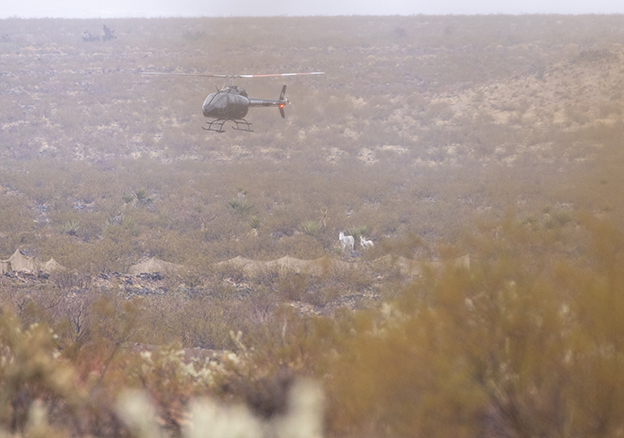

The helicopter navigates burros into the wings of the trap.
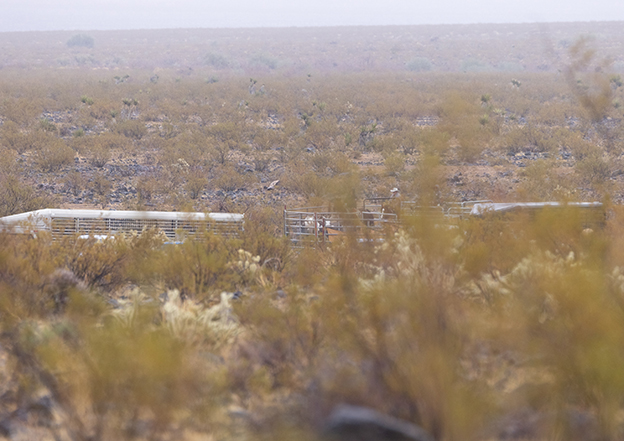
Burros in the trap, with wranglers coming in behind.
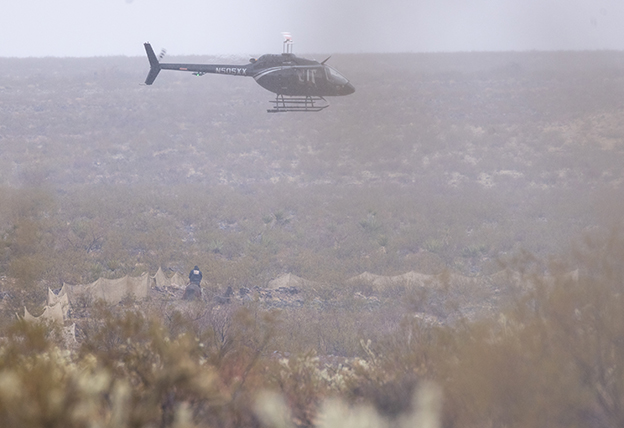
A few burros scatter in the wings, and one is roped.
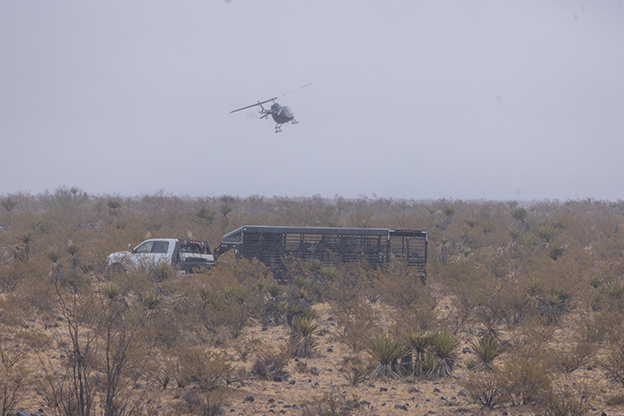
A load of burros headed to temporary holding, with the helicopter searching for more burros in the background.
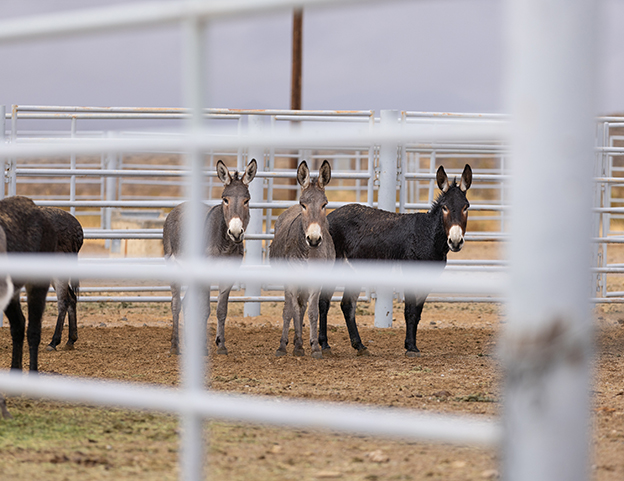
Jennies in temporary holding.

Captured burros were fed and were actively eating.
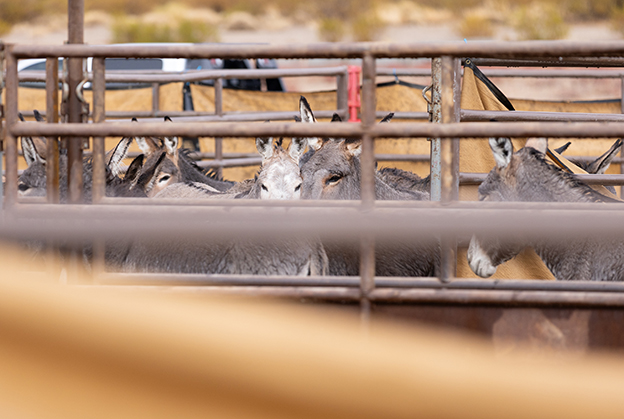
A pen of jacks at temporary holding.
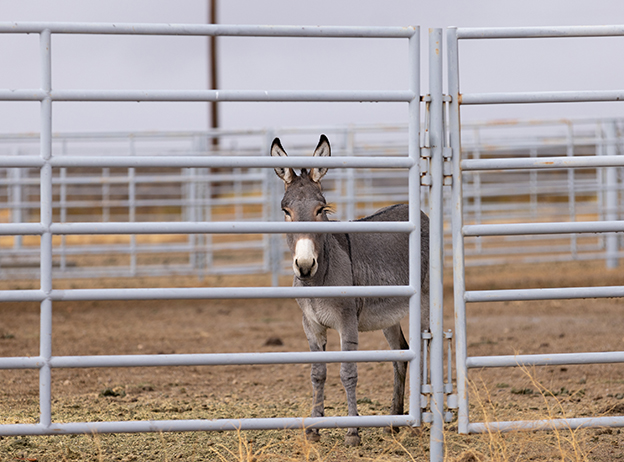
A burro watches AWHC’s observer as they walk around temporary holding
Date: January 20, 2024
Location: ~25 miles Southwest of Kingman, AZ (same as the 17th and 18th)
Weather Conditions:
- 50s (°F)
- Cloudy
- Rained briefly in AM before observers arrived
- Slight wind
Summary:
A new helicopter was brought in this morning as the other was still being serviced. Communication with the BLM has been good, and they have kept AWHC’s onsite observer informed with meet times, delays, and other relevant information. A number of group sizes were trapped, ranging from medium (~10 burros) to large (~50 burros). A few burros brought into the trap broke off from the main group. In one case, a foal separated from its group and was roped. Wranglers used horses to guide the foal and let the foal set the pace. There were no injuries or deaths observed.
Total Captured Today:
114 (39 jacks, 55 jennies, 20 foals)
BLM euthanized 1 burro with a pre-existing condition:
- A jack captured on the 18th – euthanized at temporary holding due to an old leg break
Observations and Events:
- A new helicopter was brought in this morning as the other was still being serviced
- 9:00 AM: Met at the turnoff to the observation point
- 10:30 AM: Heard the helicopter
- 11:18: Briefly caught sight of the helictopre on the horizon a few miles to the south
- 12:18 PM: A group of 10 burros came into the wings and were driven in to the trap by 6 wranglers
- 12:38 PM: A large group headed towards the trap
- 12:46 PM: Approximately 25 burros entered the wings
o A few broke off before entering the wings and ran south - Pilot refueled
- 1:14 PM: A group of around 14 burros came into the trap.
o 5 broke off from the main group as they entered the wings and ran into the hills
o The pilot retrieved these 5 and they entered the trap at 1:25 PM - A foal was seen running southeast
o Two wrangles are a helicopter went to the foal and it was roped at 1:45 PM
o The riders placed the foal between them so the horses guideded the foal’s movement
o Wranglers matched the pace of the foal
o It took 30 minutes for the foal to make it to the trap - During the roping of the foal, the first two loaded trailers headed for temporary holding
- 2:48 PM: The pilot navigates a few smaller groups together in order to drive them into the trap
- 3:07 PM: A large group of around 50 burros enters the trap
- 3:23 PM: Another dozen burros enter the trap.
- Operations end for the day.
- Due to the late hour that burros will arrive to temporary holding pens, temporary holding could not be visited today.
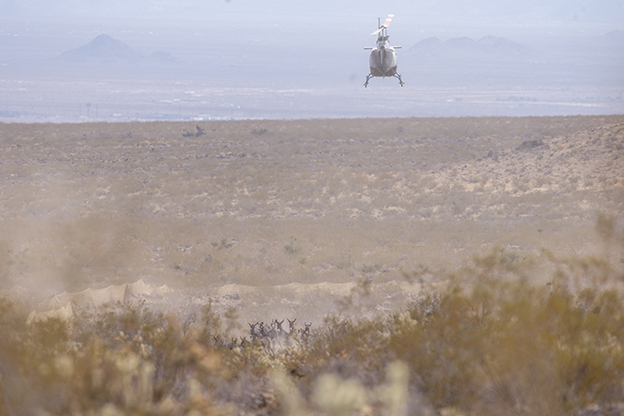
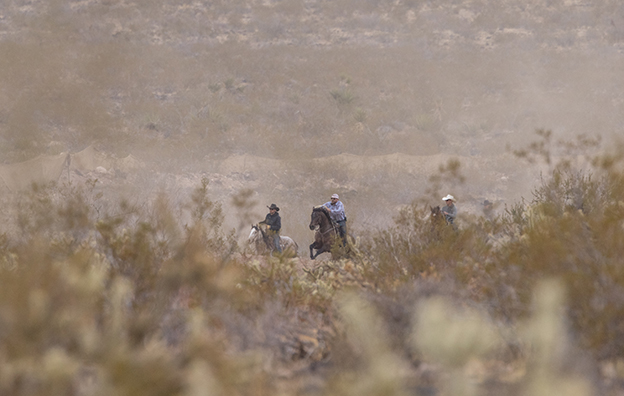

Burros entering the wings of the trap pursued by helicopter (photo 1), being driven into the trap by wranglers (photo 2), and entering the trap (photo 3; obscured by vehicles)
Wranglers driving burros all the way into the trap, which is just visible over the top of the livestock trailer parked in front.

A group of burros being driven towards the trap. They have not yet entered the trap wings.
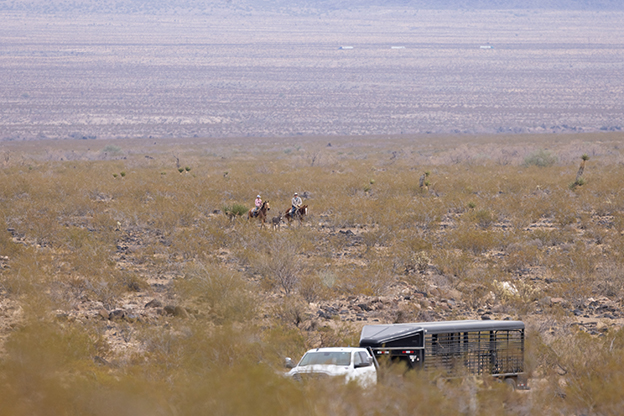
A foal that had been separated from its group is roped and brought to the trap.
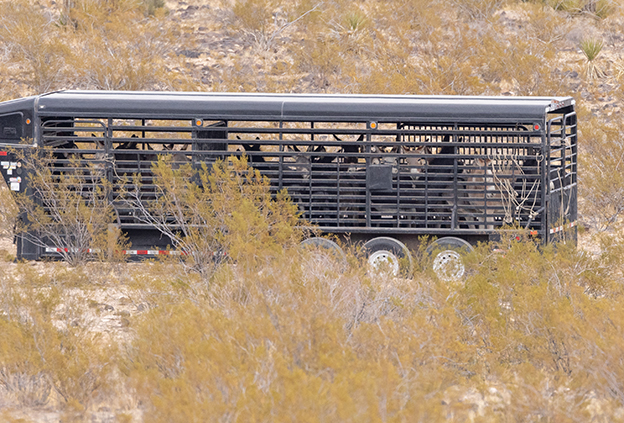
During the roping of the foal, two trailers of burros were loaded for transit to temporary holding.
Date: January 19, 2024
Summary:
The helicopter was down for maintenance and roundup operations did not occur. AWHC’s onsite observer was escorted to temporary holding in the late morning. It was quiet and burros had plenty of feed and water. After visiting temporary holding, the onsite observer searched for still wild burros on the back roads of the HMA.
The famed town of Oatman falls within the HMA. This old mining town draws people from all over and is known to be inhabited by burros. While it is illegal to feed wild horses and burros, people are able to buy alfalfa cubes to feed the Oatman burros. When our observer asked the BLM representative about this, he stated the BLM has an agreement with the town to not have more than 10 burros in town. Unfortunately, there is a lack of education about feeding the burros outside of the town. Our observer saw a number of people feeding them, drawing them to dangerous areas of the curvy road where they would then linger and approach any car that slowed down. This can lead to dangerous vehicle strikes, which can kill and injure both burros and humans. If you’re planning on visiting a wild burro HMA, please check out AWHC’s simple guidelines to ensure a safe adventure for all.
Observations and Events:
- 11:00 AM: Visited temporary holding
- Most burros had been shipped prior to AWHC’s arrival
- One pen of jacks and one pen of jennies treated with PZP remained at temporary holding
- A range of colors have been selected for release: whites, darks, and pintos
- Burros have plenty of feed and water
- It was quiet at temporary holding, with only the BLM PR on site and contractors feeding and watering the burros.
- After visiting temporary holding, AWHC’s onsite observer explored the backroads of the HMA
- Many ATVs were also on the backroads
- There were a number of mining sites on the HMA
- A few small groups of burros were visible off the road over a course of 10 miles
o These groups were wild and apprehensive of people - Outside of Oatman, a small group of burros was lingering by the road
o Out of 11 cars that stopped, 4 fed the burros
o The burros were located on a dangerous curve in the road
o Burros stayed in the road after cars left
o Burros approached cars that slowed down
o These burros were at increased risk of collisions with vehicles - BLM explained that there is an agreement with Oatman to allow up to 10 burros in town, and only 1 jack.
o Alfalfa blocks are available in town for people to buy and feed to burros residing within the town of Oatman
o Burros outside of Oatman should not be fed
o There are no signs or other obvious sources of information on when it is or isn’t appropriate to feed burros
o There is a need for education of visitors such as signs outside of town or along already established pullouts and information kiosks along Route 66
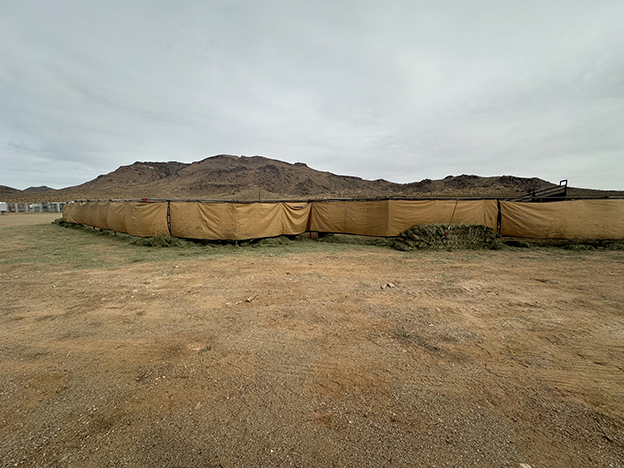
Tarps lining panels at temporary holding. Plenty of hay and water is available to the burros.
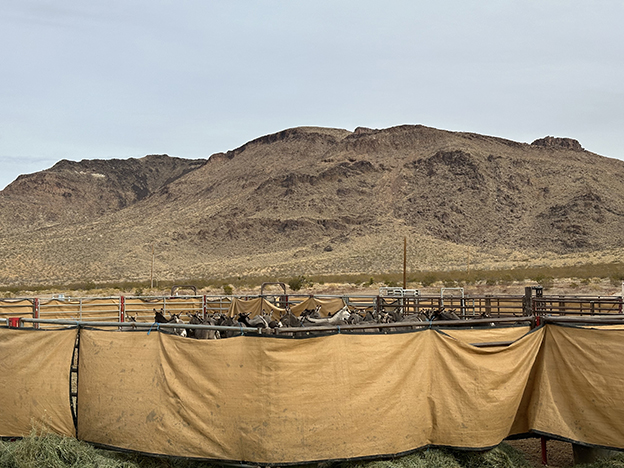
Jacks (male burros) in a pen at temporary holding. Provided hay can be seen at the bottom of the image.
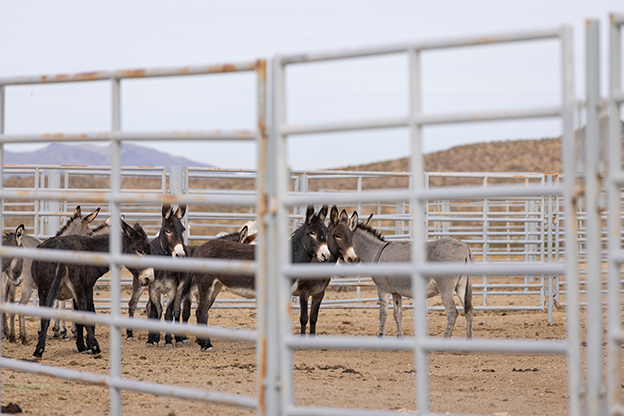
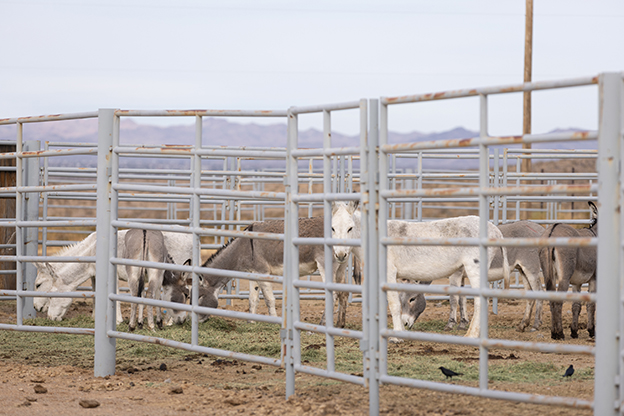
Jennies (female burros) which have been treated with PZP at temporary holding. These jennies may be selected for release. A variety of colors have been chosen to introduce more color variety into the HMA.
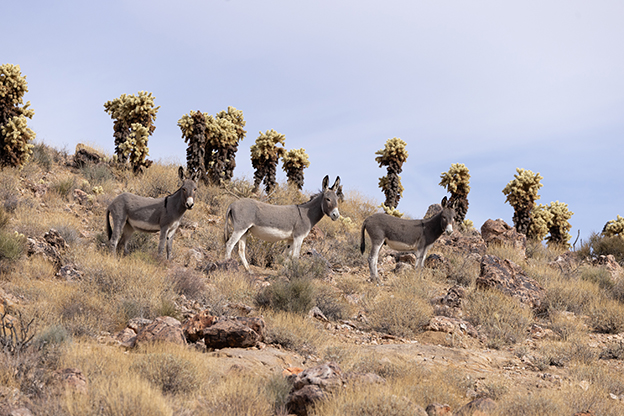
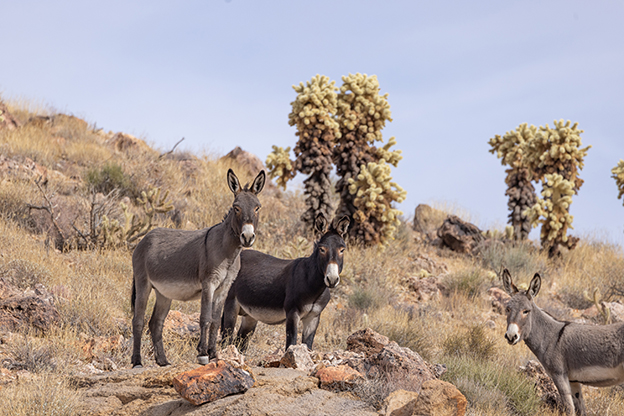

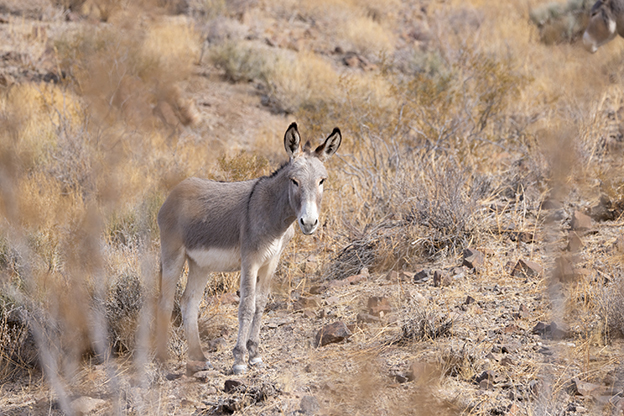
Groups of wild burros along the backroads of Black Mountain HMA.
Date: January 18, 2024
Location: ~25 miles Southwest of Kingman, AZ
Weather Conditions:
- Upper 60s (°F)
- Sunny
Summary:
Approximately 50 burros were gathered prior to AWHC’s onsite observer meeting with BLM staff. Between runs, the BLM escorted AWHC to the observation area, which was only ¼ mile from the trap site. Vegetation and topography did not allow for a complete view of the trap and trap wings, but burros could be seen in the wings of the trap and on livestock trailers headed to temporary holding. Several large groups (>40 burros) were brought in today with no injuries or deaths seen or reported. Due to transportation of burros continuing until dark, AWHC’s observer was not able to visit temporary holding today.
Total Captured Today:
171 (51 jacks, 95 jennies, and 25 foals)
Observations and Events:
- 9:35 AM: Left Kingman, AZ and traveled ~24 miles Southwest
- Observers waited outside a kiosk at Route 66 to be brought in to observation between runs
- Approximately 50 burros had been gathered prior to the arrival of AWHC’s onsite observer
- Shortly after 11:00 AM: Drove to the observation area
- Vehicles were parked in a low spot
- The observation site was an ~1/4 mile walk
- The trap site was ~1/4 mile from observation
- Terrain, bushes, and contractor vehicles obscured a complete view of the trap
- Shortly before 1:00 PM: A large group of burros (~40-45) ran into the wings
o The helicopter brings the burros into the wings of the trap
o 6 wranglers ride behind the burros entering the trap - 2 trailers left, transferring burros to temporary holding
- 2:00 PM: A large group of burros is brought towards the trap
- 2:14 PM: A group of ~10 enter the trap
- 2:33 PM: A group of over 50 burros enter the trap
- 2:50 PM: A group of 6 that had broken off from the main group is brought into the trap
- Operations are ended for the day
Temporary Holding
AWHC’s observer was taken to the turnoff to temporary holding. Unfortunately, the onsite observer was not able to see temporary holding today due to it being late in the day and with burros still needing to be brought in. Temporary holding is only 16 miles from the trap site, but rough dirt roads mean that it takes extra time to bring burros to the location.
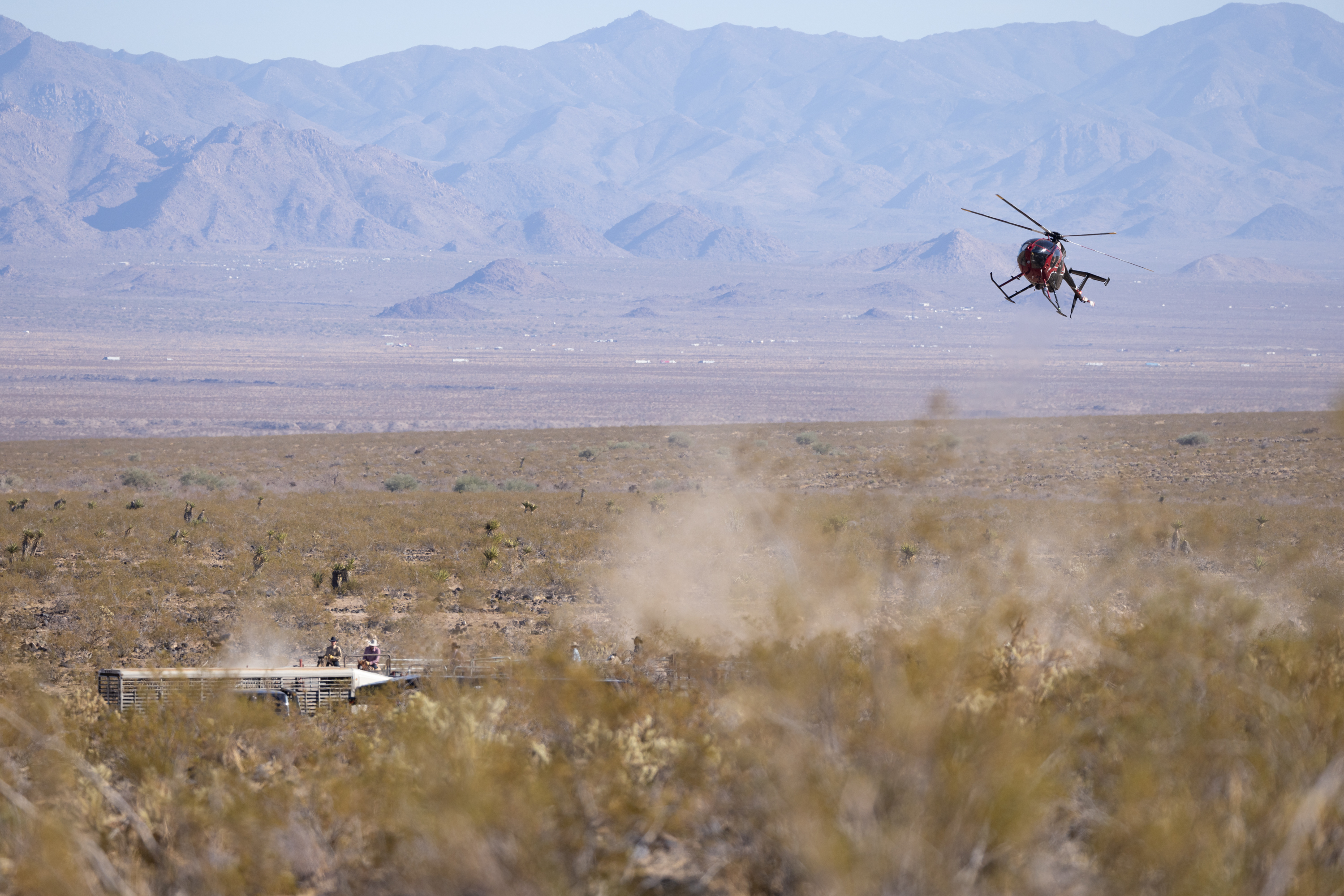
View of the trap site from the observation point
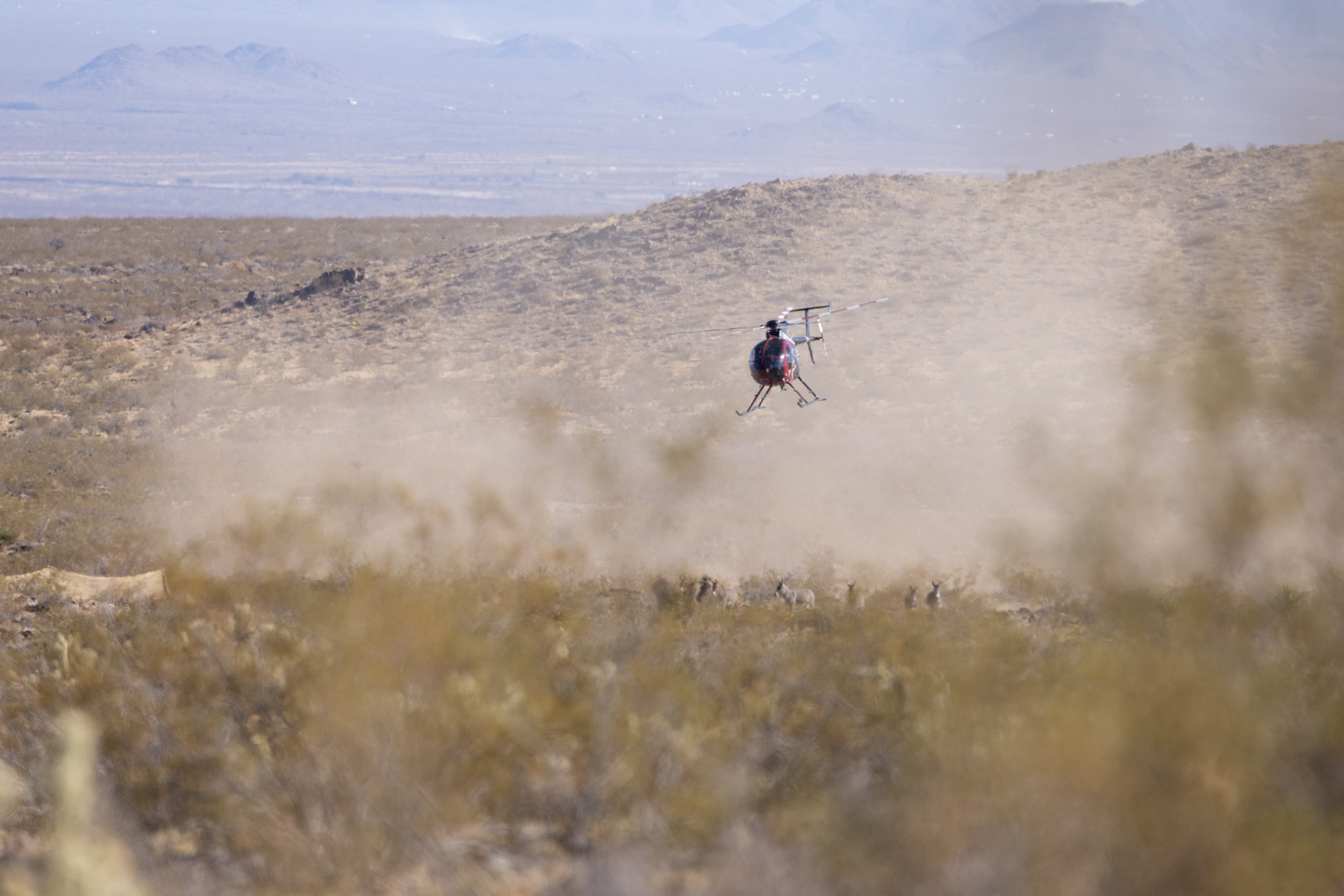
A helicopter brings in a group of burros. The jute making up trap wings can be seen on the left side of the image

Wranglers on horseback follow the burros into the trap
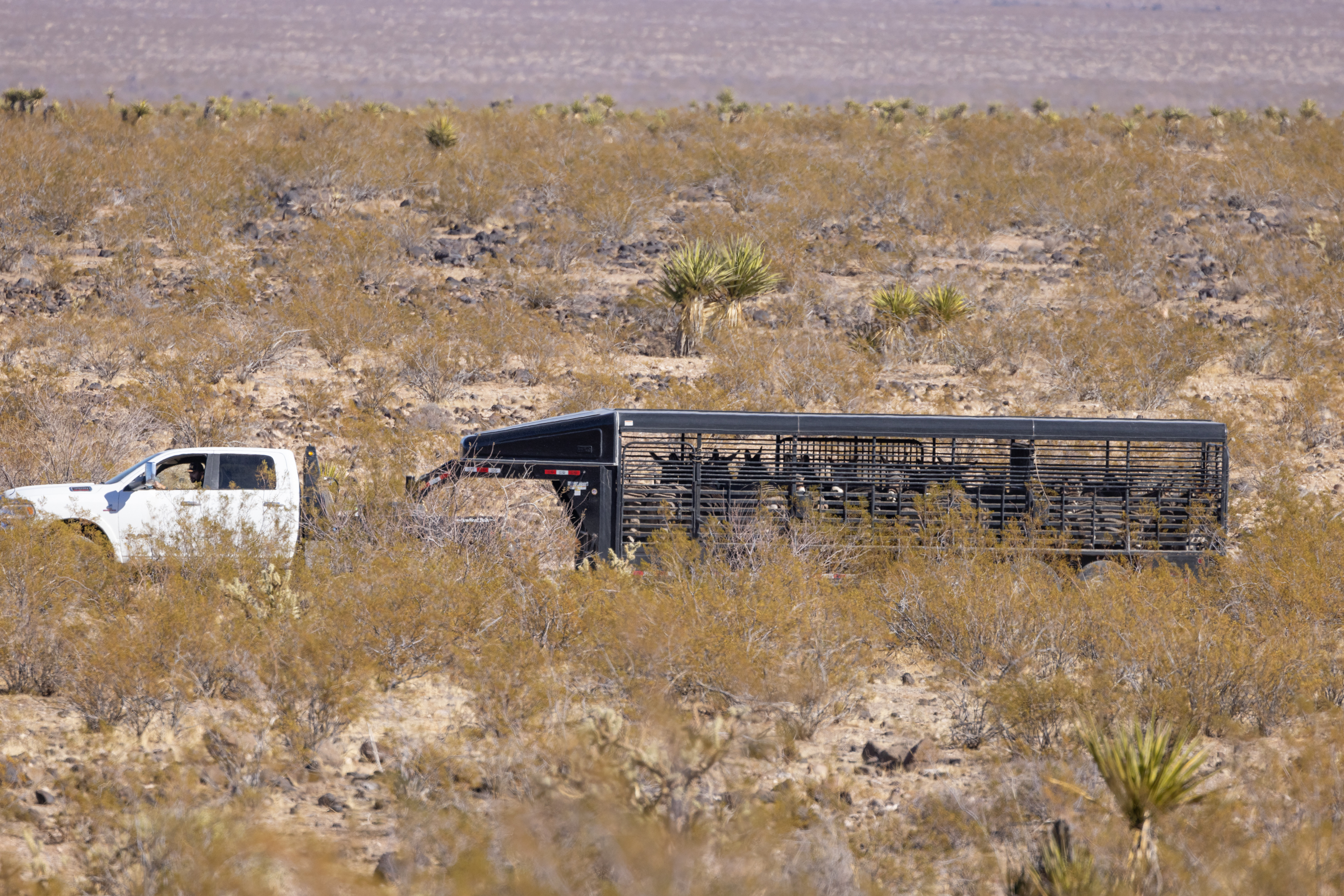
Burros loaded onto trailers and headed to temporary holding
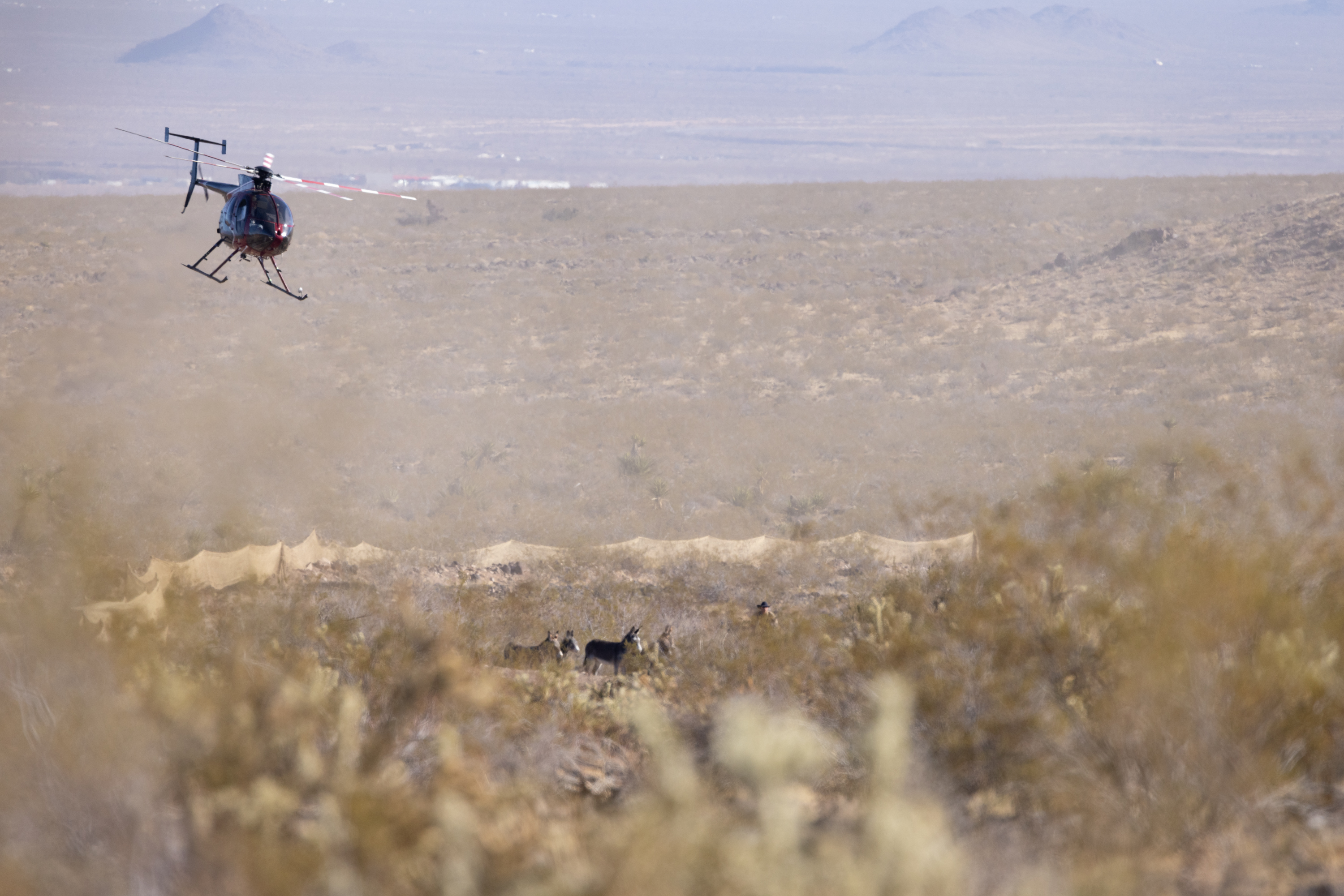
Burros in the wings of the trap
Part 1: A large group of Black Mountain burros brought into the trap. Video shows the wings of the trap, the helicopter pressuring burros towards the trap, and wranglers pushing the burros into the trap.
Part 2: Burros on a livestock trailer headed to temporary holding


